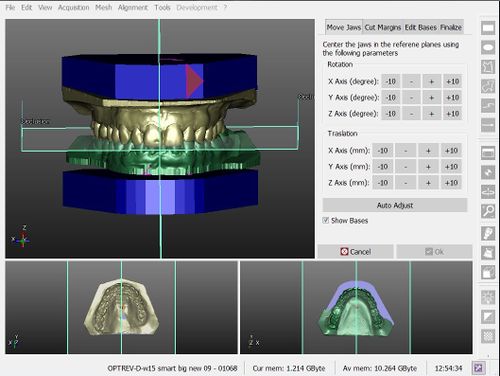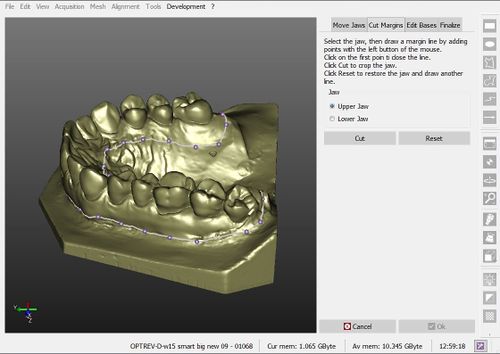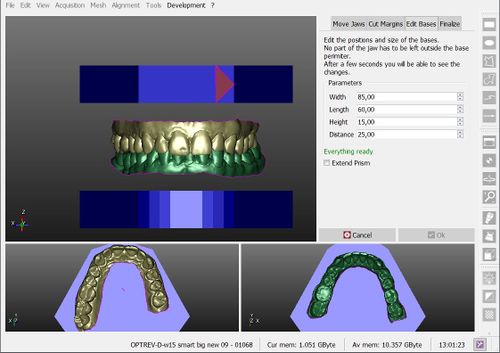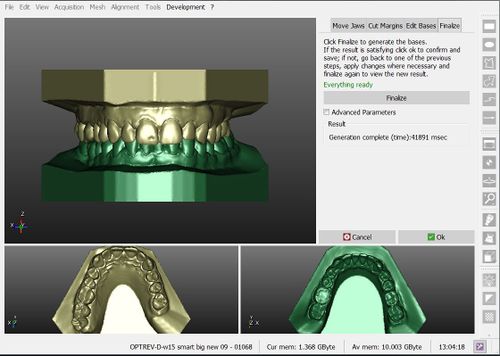Difference between revisions of "Man ModelTrimming/de"
(Created page with "Eine zusätzliche Option ist Grundlagen anzeigen, mithilfe derer eine Vorschau der Position der geometrischen Grundlagen angezeigt wird, um die Positionierung der Zahnbögen z...") |
(Created page with "==Ausschnittsrand==") |
||
| Line 35: | Line 35: | ||
{{Screenshot|Dental 2 5 ortoBasePosition.jpg}} | {{Screenshot|Dental 2 5 ortoBasePosition.jpg}} | ||
| − | == | + | ==Ausschnittsrand== |
The jaw meshes acquired from the scanner often have residual unnecessary parts of information. This parts have to be removed before merging the data with the new trimmed base. | The jaw meshes acquired from the scanner often have residual unnecessary parts of information. This parts have to be removed before merging the data with the new trimmed base. | ||
Revision as of 11:13, 1 February 2016
Contents
Grundlagenschnitt
Das Werkzeug “Grundlage Kieferorthopädie” ist nur in den Zusatzmodi “Kieferorthopädie” und “Zahnabdruck” verfügbar. Dieses Werkzeug hat die Funktion, eine regelmäßige Grundlage für das Schließen einer oder beider Projektzahnbögen zu erstellen.
Um das Werkzeug zu starten, auf das jeweilige Icon ![]() in der Hauptwerkzeugleiste klicken; Das Icon ist nur verfügbar, wenn das Projekt mindestens ein Mesh enthält.
in der Hauptwerkzeugleiste klicken; Das Icon ist nur verfügbar, wenn das Projekt mindestens ein Mesh enthält.
Interface
Das Interface für die Erstellung der Kieferorthopädiegrundlage unterscheidet sich vom Rest der Software. Oben rechts werden die 4 Schritte des Prozesses angezeigt. Der Rest des Fensters besteht aus einer oder drei 3D-Ansichtsfenstern:
- Einzelmaske : Beim Ausschneiden der Ränder, wird eine einzige 3D-Ansichtsmaske bzw. jeder Zahnbogen einzeln angezeigt.
- Drei Masken: Bei allen anderen Schritten werden beide Zahnbögen angezeigt, damit der Nutzer gleichzeitig die Grundlage überprüfen kann.
Schritte
Der Vorgang besteht aus 4 Schritten:
- Zahnbögen bewegen: Die Zahnbögen können nach bestimmten Parametern (Okklusion und Symmetrie) bewegt bzw. adaptiert werden.
- Ausschnittsrand: Hier wird ein Ausschnittsrand auf jedes Mesh gezeichnet, um alle mit der geometrischen Grundlage zu ersetzenden Informationen auszuschneiden.
- Grundlagen anpassen : Form und Position der geometrischen Grundlagen werden geändert, um sie an die Zahnbögen anzupassen.
- Finalisieren : Das finalisierte Mesh erstellen und die abgeschnittenen Zahnbögen mit der geometrischen Grundlage zusammensetzen.
Zahnbögen bewegen
Die Position der Meshes der gescannten Zahnbögen ist nicht immer gleich. Dieses Werkzeug dient zur Anpassung Position der Zahnbögen.
Für jede Bewegung sind 4 Tasten verfügbar (-10, -, +, +10), die das Objekt auf eine bestimmte Art und Weise bewegen.
Alle Bewegungen (Rotation und Translation) werden nach einer Achse bestimmt. Die Achse ist in der 3D-Ansicht, in der linken unteren Ecke sichtbar.
Eine zusätzliche Option ist Grundlagen anzeigen, mithilfe derer eine Vorschau der Position der geometrischen Grundlagen angezeigt wird, um die Positionierung der Zahnbögen zu erleichtern.
Ausschnittsrand
The jaw meshes acquired from the scanner often have residual unnecessary parts of information. This parts have to be removed before merging the data with the new trimmed base.
Fort his purpose, an interactive tool that can draw a line on the mesh surface is provided:
- The first left mouse click on the mesh surface creates a point and starts the margin definition
- Any additional left mouse click adds a point to the margin and connects it to the previous one
- A left mouse click on the first point closes the margin
- After the margin is closed, the user can:
- drag one point with the left mouse button to move it to a different position
- click between two points, to add a new point in the middle
- press ESC to delete the margin and start again
When the margin is defined, a click on the Cut button will remove all the parts of the mesh below the margin.
Adjust Bases
The user can change 4 different parameters of the bases. When a parameter is changed, the 3D view updates in approximately 2 seconds.
- Width : the maximum width of the base
- Length : the maximum length of the base
- Height : the base height
- Distance : distance between the two bases, which are symmetric to the occlusal plane
After the cut, the jaw meshes have to be completely fitted in the bases. If the bases are too small a warning message will appear below the parameters.
Finalize
This last page shows only the Finalize button. When clicked, the software takes all the data and computes the new, closed, mesh. This process can take up to 2 minutes.
If the result is not satisfactory for the user, it is possible to return to one of the previous steps, change parameters and positions and then return to the Finalize step and compute the meshes again.
Otherwise, if the finalized mesh is satisfactory, click Ok to confirm the base trimming and save the new meshes.






